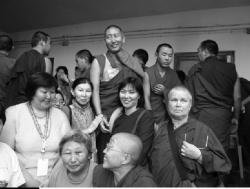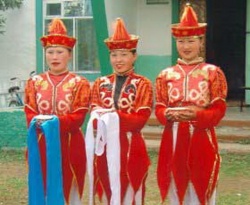Buryats
The Buryats, or the Buryat-Mongols, (Buryat: Буряад, Buryaad; Буряад-монгол; Mongolian: Буриад), numbering approximately 500,000, are the largest indigenous (aboriginal) group in Siberia, mainly concentrated in their homeland, the Buryat Republic, a federal subject of Russia. They are the major northern subgroup of the Mongols.
Buryats share many customs with other Mongols, including nomadic herding, and erecting gers for shelter. Today, the majority of Buryats live in and around Ulan-Ude, the capital of the republic, although many live more traditionally in the countryside. They speak in a dialect of Mongol language called Buryat.
The Buryat people are descended from various Siberian and Mongolic peoples that inhabited the Lake Baikal Region. Then in the 13th century the Mongolians came up and enslaved the various Buryat tribes around Lake Baikal. The name "Buriyad" is mentioned as one of the forest people for the first time in The Secret History of the Mongols (possibly 1240). It says Jochi, the eldest son of Genghis Khan, marched north to subjugate the Buryats in 1207. The Buryats lived along the Angara River and its tributaries at this time. Meanwhile, their component, Barga, appeared both west of Baikal and in northern Buryatia's Barguzin valley. Linked also to the Bargas were the Khori-Tumed along the Arig River in eastern Khövsgöl Province and the Angara. A Tumad rebellion broke out in 1217, when Genghis Khan allowed his viceroy to seize 30 Tumad maidens. Genghis Khan's commander Dorbei the Fierce of the Dörbeds smashed them in response. The Buryats joined the Oirats challenging the imperial rule of the Eastern Mongols during the Northern Yuan period in the late 14th century.
Historically, the territories around lake Baikal belonged to Khalkha and the local people, Buryats were subject to Khalkha Tusheet Khan and Setsen Khan. When the Russians expanded into Transbaikalia (eastern Siberia) in 1609, the Cossacks found only a small core of tribal groups speaking a Mongol dialect called Buryat and paying tribute to the Khalkhas. However, they were powerful enough to compel the Ket and Samoyed peoples on the Kan and the Evenks on the lower Angara to pay tribute. The ancestors of most modern Buryats were speaking a variety of Turkic-Tungusic dialects at that time. In addition to genuine Buryat-Mongol tribes (Bul(a)gad, Khori, Ekhired, Khongoodor) that merged with the Buryats, the Buryats also assimilated other groups, including some Oirats, the Khalkha, Tungus (Evenks) and others. The Khori-Barga had migrated out of the Barguzin eastward to the lands between the Greater Khingan and the Argun. Around 1594 most of them fled back to the Aga and Nerchinsk in order to escape subjection by the Daurs. The territory and people were formally annexed to the Russian state by treaties in 1689 and 1727, when the territories on both the sides of Lake Baikal were separated from Mongolia. Consolidation of modern Buryat tribes and groups took place under the conditions of the Russian state. From the middle of the 17th century to the beginning of the 20th century, the Buryat population increased from 27,700 to 300,000.
Another estimate of the rapid growth in people referring to themselves as Buryat is based on the clan list names paying tribute in the form of a sable-skin tax. This indicates a population of about 25,000 in 1640 rising to 157,000 in 1823 and more than a million by 1950.
The historical roots of the Buryat culture are related to the Mongolic peoples. After Buryatia was incorporated into Russia, it was exposed to two traditions – Buddhist and Christian. Buryats west of Lake Baikal and Olkhon (Irkut Buryats), are more "russified", and they soon abandoned nomadism for agriculture, whereas the eastern (Transbaikal) Buryats are closer to the Khalkha, may live in yurts and are mostly Buddhists. In 1741, the Tibetan branch of Buddhism was recognized as one of the official religions in Russia, and the first Buryat datsan (Buddhist monastery) was built.
The second half of the 19th century and the beginning of the 20th century was a time of growth for the Buryat Buddhist church (48 datsans in Buryatia in 1914). Buddhism became an important factor in the cultural development of Buryatia. Because of their skills in horsemanship and mounted combat, many were enlisted into the Amur Cossacks host. During the Russian Civil War most of the Buryats sided with the White forces of Baron Ungern-Sternberg and Ataman Semenov. They formed a sizable portion of Ungern's forces and often received favorable treatment when compared with other ethnic groups in the Baron's army. After the Revolution, most of the lamas were loyal to the Soviet power. In 1925, a battle against religion and church in Buryatia began. Datsans were gradually closed down and the activity of the church was curtailed. Consequently, in the late 1930s the Buddhist church ceased to exist and thousands of cultural treasures were destroyed. Attempts to revive the Buddhist Church started during World War II, and it was officially re-established in 1946. A genuine revival of Buddhism has taken place since the late 1980s as an important factor in the national consolidation and spiritual rebirth.
In 1923, the Buryat-Mongol Autonomous Soviet Socialist Republic was formed and included Baikal province (Pribaykalskaya guberniya) with Russian population. The Buryats rebelled against the communist rule and collectivization of their herds in 1929. The rebellion was quickly crushed by the Red Army with loss of 35,000 Buryats. The Buryat refugees fled to Mongolia and resettled, however, only a few of them joined the Shambala rebellion there. In 1937, in an effort to disperse Buryats, Stalin's government separated a number of counties (raions) from the Buryat-Mongol ASSR and formed Ust-Orda Buryat Autonomous Okrug and Aga Buryat Autonomous Okrug; at the same time, some raions with Buryat populations were left out. Fearing Buryat nationalism, Joseph Stalin had more than 10,000 Buryats killed. Moreover, Stalinist purge of Buryats spread into Mongolia, known as the incident of Lhumbee. In 1958, the name "Mongol" was removed from the name of the republic (Buryat ASSR). BASSR declared its sovereignty in 1990 and adopted the name Republic of Buryatia in 1992. The constitution of the Republic was adopted by the People's Khural in 1994, and a bilateral treaty with the Russian Federation was signed in 1995.

